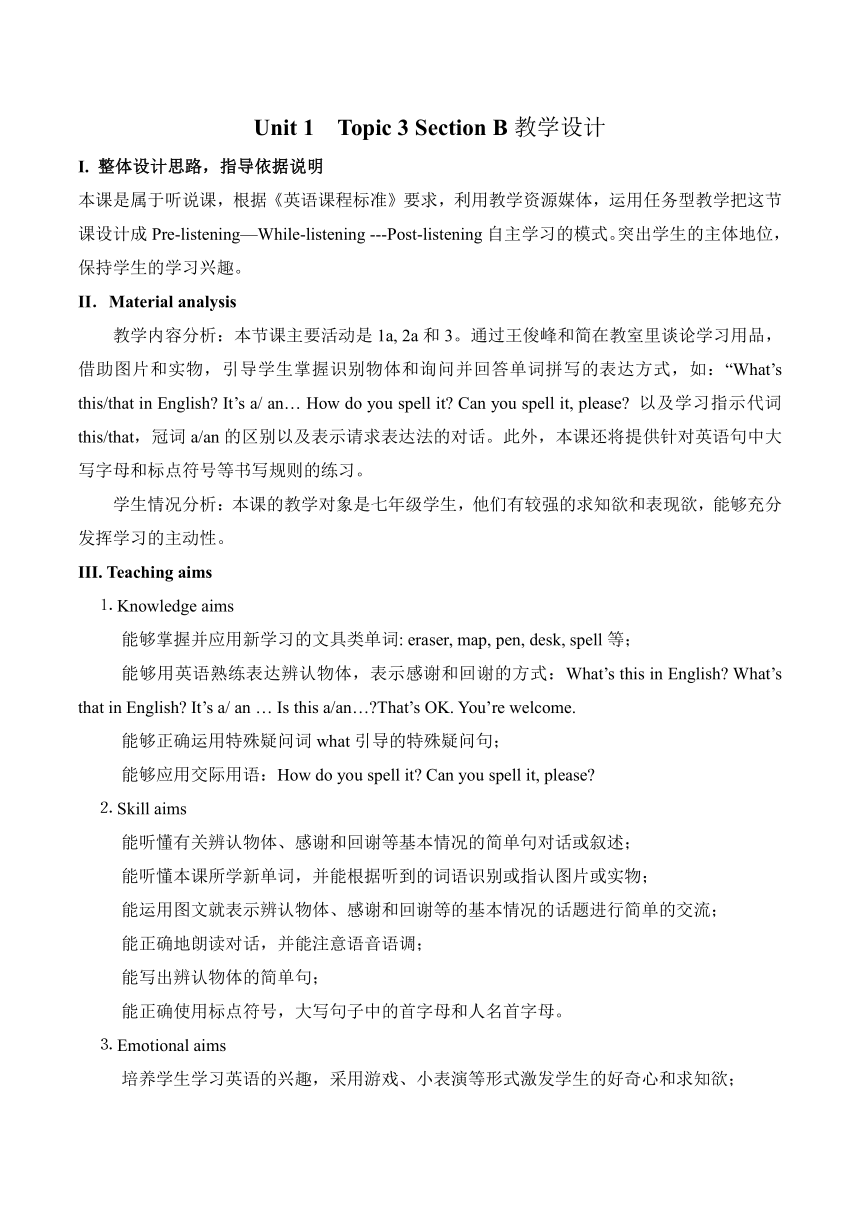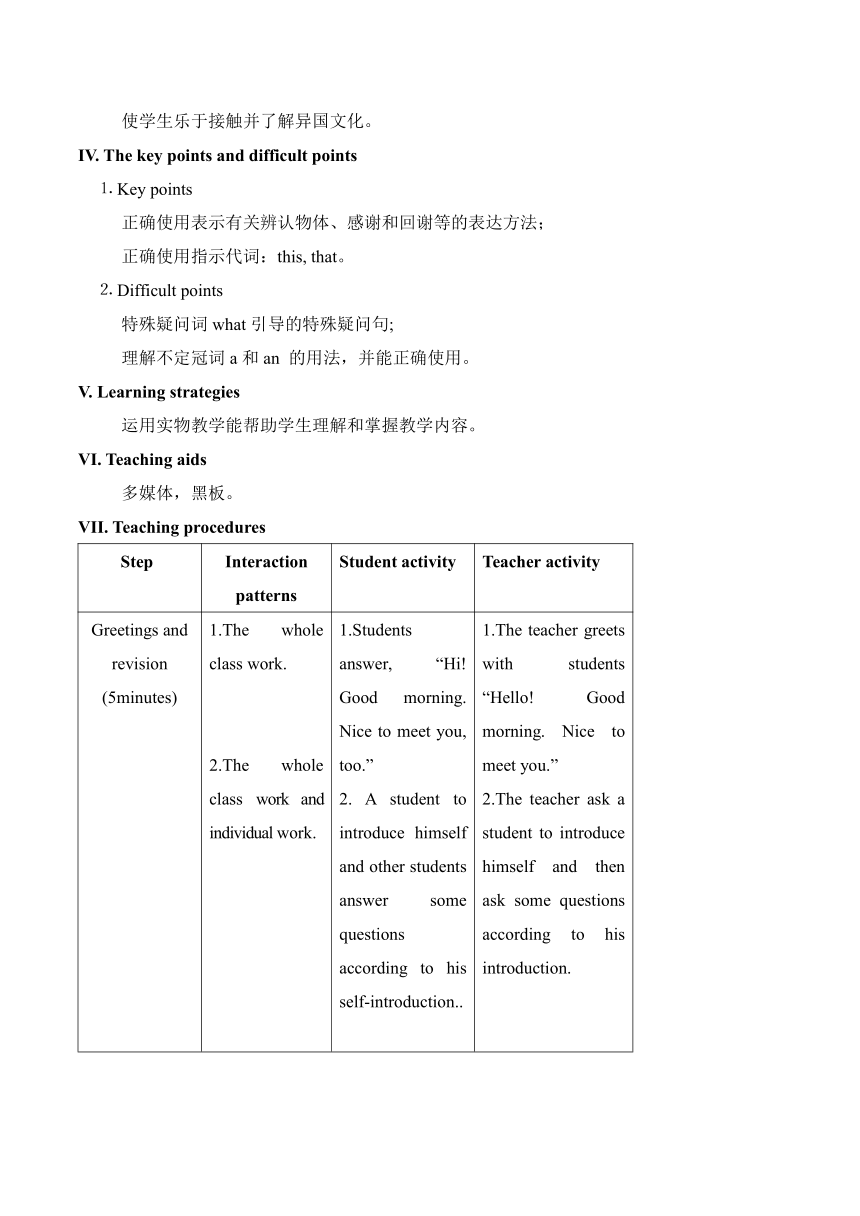Unit 1 Topic 3 How old are you? Section B 表格式教学设计
文档属性
| 名称 | Unit 1 Topic 3 How old are you? Section B 表格式教学设计 |

|
|
| 格式 | docx | ||
| 文件大小 | 18.0KB | ||
| 资源类型 | 教案 | ||
| 版本资源 | 仁爱科普版 | ||
| 科目 | 英语 | ||
| 更新时间 | 2023-09-02 13:41:32 | ||
图片预览



文档简介
Unit 1 Topic 3 Section B教学设计
Ⅰ. 整体设计思路,指导依据说明
本课是属于听说课,根据《英语课程标准》要求,利用教学资源媒体,运用任务型教学把这节课设计成Pre-listening—While-listening ---Post-listening自主学习的模式。突出学生的主体地位,保持学生的学习兴趣。
II.Material analysis
教学内容分析:本节课主要活动是1a, 2a和3。通过王俊峰和简在教室里谈论学习用品,借助图片和实物,引导学生掌握识别物体和询问并回答单词拼写的表达方式,如:“What’s this/that in English It’s a/ an… How do you spell it Can you spell it, please 以及学习指示代词this/that,冠词a/an的区别以及表示请求表达法的对话。此外,本课还将提供针对英语句中大写字母和标点符号等书写规则的练习。
学生情况分析:本课的教学对象是七年级学生,他们有较强的求知欲和表现欲,能够充分发挥学习的主动性。
III. Teaching aims
⒈ Knowledge aims
能够掌握并应用新学习的文具类单词: eraser, map, pen, desk, spell等;
能够用英语熟练表达辨认物体,表示感谢和回谢的方式:What’s this in English What’s that in English It’s a/ an … Is this a/an… That’s OK. You’re welcome.
能够正确运用特殊疑问词what引导的特殊疑问句;
能够应用交际用语:How do you spell it Can you spell it, please
⒉ Skill aims
能听懂有关辨认物体、感谢和回谢等基本情况的简单句对话或叙述;
能听懂本课所学新单词,并能根据听到的词语识别或指认图片或实物;
能运用图文就表示辨认物体、感谢和回谢等的基本情况的话题进行简单的交流;
能正确地朗读对话,并能注意语音语调;
能写出辨认物体的简单句;
能正确使用标点符号,大写句子中的首字母和人名首字母。
⒊ Emotional aims
培养学生学习英语的兴趣,采用游戏、小表演等形式激发学生的好奇心和求知欲;
使学生乐于接触并了解异国文化。
IV. The key points and difficult points
⒈ Key points
正确使用表示有关辨认物体、感谢和回谢等的表达方法;
正确使用指示代词:this, that。
⒉ Difficult points
特殊疑问词what引导的特殊疑问句;
理解不定冠词a和an 的用法,并能正确使用。
V. Learning strategies
运用实物教学能帮助学生理解和掌握教学内容。
VI. Teaching aids
多媒体,黑板。
VII. Teaching procedures
Step Interaction patterns Student activity Teacher activity
Greetings and revision (5minutes) 1.The whole class work. 2.The whole class work and individual work. 1.Students answer, “Hi! Good morning. Nice to meet you, too.” 2. A student to introduce himself and other students answer some questions according to his self-introduction.. 1.The teacher greets with students “Hello! Good morning. Nice to meet you.” 2.The teacher ask a student to introduce himself and then ask some questions according to his introduction.
Pre-listening (13minutes) 1.The whole class work and pair work. 1.Learn the new words. Listen and read the word out according to the sound and pictures. Then follow the teacher; Listen and follow the teacher; Follow the teacher; Listen and follow the teacher for several times; T:What’s this Ss:Eraser. T:What’s this in English Ss:It’s an eraser. Talk about the question in pairs. A: Thank you./ Thanks. B: That’s OK./ You’re welcome. 1.Point a desk to students and say: “What’s this in English ”. Present /desk/ and teach the word for several times; Then ask, “How do you spell it ” Teach the sentence for several times; Spell it, “D-E-S-K, desk” and let students follow the teacher for one time; Point to a pen over there and ask: “What’s that in English ” Then let students listen and follow the teacher for several times; Ask,“Can you spell it, please ” Then teach the sentence for several times; Ask,“What will you say if someone helps you What will you respond if someone thank you for your help ” Let students talk about the question in pairs and choose one student to show his/her idea;
While-listening(15minutes) 1.The whole class work and pair work. 2.Individual work. 3.Pair work. 1. Do 1a.Students listen to the tape and follow the tape for the first time. 2.Listen to and follow the tape for the second time; Then practice the two conversations in pairs; And two pairs show the conversations. 3.Do 1b. Listen and complete the conversations and then check the answers. 1.Let students listen to the tape and pay attention to the key sentences. What’s this / that in English How do you spell it Can you spell it, please Thanks. You’re welcome. Then let students follow the tape for the first time. 2.Let students listen to the tape and follow it for the second time; Give students 1 minute to practice the two conversations in pairs; Choose two pairs to show the conversations. 3.Play the tape and choose two students to check the answers.
Post-listening (12minutes) 1.The whole class work. 2.Individual work. 3. Group work. 1.Do 1c. Make up new conversations in pairs and show the new conversations. 2.Do 2a. Students answer together, “Yes, it is.” Students answer together, “No, it isn’t. It’s a pen.” Students answer the teacher’s questions according to the objects. 3.Students play the guessing game; A:What’s this in English B:Is it a/an… A: No it isn’t. Please try again. Yes, it is. A:… 1.Show some pictures about map, eraser, pen, pencil and desk to students, then let them make up new conversations with them and do it in pairs, finally choose two pairs to show the conversations. 2.Show a pen and ask, “Is this a pen ” Help students answer, “Yes, it is.” Then show a pencil and ask, “Is this a pen ” Help students answer, “No, it isn’t.” Then point some other objects e.g. toy, map, telephone, and then ask and answer with students. 3.Play a game— Guess the objects. Prepare some objects in the boxes, then ask students to guess what it is in the box.
Summary (2minutes) The whole class work Summarize the key sentences and important points. Summarize the key sentences and important points. 2.Assign homework: (1)总结:在学过的名词中,哪些前面加a, 哪些前面加an。 (2)Recite 1a. (3) Recite the new words in Section B.
教学评价设计: 评价内容:本课教学设计围绕新课标要求,遵循 “以生为本”的理念,将评价的侧重点放在学生的课堂活动、回归复习及师生的课后反思,让学生清楚地认识到自己在本节课中是否掌握了知识。 评价方法: (一)学生课堂活动评价:采用形成性评价和口头评价相结合的方式。再配以老师生动夸张的口头评价,如Wonderful, Excellent等,在争强好胜的心理作用下,大大提高学生学习的积极性, (二)师生课后反思 教师反思 1. Have all the teaching aims been reached _________________ 2. Have all the students learnt something in the lesson ________________ 3. What can be improved 学生反思 1. What impressed me most in the class ________________ 2.What haven’t I understood yet ________________ 3.In what aspect do I need to improve
VIII. Blackboard design
Unit 1 Topic 3 Section B 1. —What’s this/that in English an apple a desk —It’s a/ an… an orange a map 2.How do you spell it an eraser a pen 3.Can you spell it, please a pencil 4.That’s OK. / You’re welcome. a toy 5. —Is this a/an… —Yes, it is. / No, it isn’t. It’s a/an…
Ⅰ. 整体设计思路,指导依据说明
本课是属于听说课,根据《英语课程标准》要求,利用教学资源媒体,运用任务型教学把这节课设计成Pre-listening—While-listening ---Post-listening自主学习的模式。突出学生的主体地位,保持学生的学习兴趣。
II.Material analysis
教学内容分析:本节课主要活动是1a, 2a和3。通过王俊峰和简在教室里谈论学习用品,借助图片和实物,引导学生掌握识别物体和询问并回答单词拼写的表达方式,如:“What’s this/that in English It’s a/ an… How do you spell it Can you spell it, please 以及学习指示代词this/that,冠词a/an的区别以及表示请求表达法的对话。此外,本课还将提供针对英语句中大写字母和标点符号等书写规则的练习。
学生情况分析:本课的教学对象是七年级学生,他们有较强的求知欲和表现欲,能够充分发挥学习的主动性。
III. Teaching aims
⒈ Knowledge aims
能够掌握并应用新学习的文具类单词: eraser, map, pen, desk, spell等;
能够用英语熟练表达辨认物体,表示感谢和回谢的方式:What’s this in English What’s that in English It’s a/ an … Is this a/an… That’s OK. You’re welcome.
能够正确运用特殊疑问词what引导的特殊疑问句;
能够应用交际用语:How do you spell it Can you spell it, please
⒉ Skill aims
能听懂有关辨认物体、感谢和回谢等基本情况的简单句对话或叙述;
能听懂本课所学新单词,并能根据听到的词语识别或指认图片或实物;
能运用图文就表示辨认物体、感谢和回谢等的基本情况的话题进行简单的交流;
能正确地朗读对话,并能注意语音语调;
能写出辨认物体的简单句;
能正确使用标点符号,大写句子中的首字母和人名首字母。
⒊ Emotional aims
培养学生学习英语的兴趣,采用游戏、小表演等形式激发学生的好奇心和求知欲;
使学生乐于接触并了解异国文化。
IV. The key points and difficult points
⒈ Key points
正确使用表示有关辨认物体、感谢和回谢等的表达方法;
正确使用指示代词:this, that。
⒉ Difficult points
特殊疑问词what引导的特殊疑问句;
理解不定冠词a和an 的用法,并能正确使用。
V. Learning strategies
运用实物教学能帮助学生理解和掌握教学内容。
VI. Teaching aids
多媒体,黑板。
VII. Teaching procedures
Step Interaction patterns Student activity Teacher activity
Greetings and revision (5minutes) 1.The whole class work. 2.The whole class work and individual work. 1.Students answer, “Hi! Good morning. Nice to meet you, too.” 2. A student to introduce himself and other students answer some questions according to his self-introduction.. 1.The teacher greets with students “Hello! Good morning. Nice to meet you.” 2.The teacher ask a student to introduce himself and then ask some questions according to his introduction.
Pre-listening (13minutes) 1.The whole class work and pair work. 1.Learn the new words. Listen and read the word out according to the sound and pictures. Then follow the teacher; Listen and follow the teacher; Follow the teacher; Listen and follow the teacher for several times; T:What’s this Ss:Eraser. T:What’s this in English Ss:It’s an eraser. Talk about the question in pairs. A: Thank you./ Thanks. B: That’s OK./ You’re welcome. 1.Point a desk to students and say: “What’s this in English ”. Present /desk/ and teach the word for several times; Then ask, “How do you spell it ” Teach the sentence for several times; Spell it, “D-E-S-K, desk” and let students follow the teacher for one time; Point to a pen over there and ask: “What’s that in English ” Then let students listen and follow the teacher for several times; Ask,“Can you spell it, please ” Then teach the sentence for several times; Ask,“What will you say if someone helps you What will you respond if someone thank you for your help ” Let students talk about the question in pairs and choose one student to show his/her idea;
While-listening(15minutes) 1.The whole class work and pair work. 2.Individual work. 3.Pair work. 1. Do 1a.Students listen to the tape and follow the tape for the first time. 2.Listen to and follow the tape for the second time; Then practice the two conversations in pairs; And two pairs show the conversations. 3.Do 1b. Listen and complete the conversations and then check the answers. 1.Let students listen to the tape and pay attention to the key sentences. What’s this / that in English How do you spell it Can you spell it, please Thanks. You’re welcome. Then let students follow the tape for the first time. 2.Let students listen to the tape and follow it for the second time; Give students 1 minute to practice the two conversations in pairs; Choose two pairs to show the conversations. 3.Play the tape and choose two students to check the answers.
Post-listening (12minutes) 1.The whole class work. 2.Individual work. 3. Group work. 1.Do 1c. Make up new conversations in pairs and show the new conversations. 2.Do 2a. Students answer together, “Yes, it is.” Students answer together, “No, it isn’t. It’s a pen.” Students answer the teacher’s questions according to the objects. 3.Students play the guessing game; A:What’s this in English B:Is it a/an… A: No it isn’t. Please try again. Yes, it is. A:… 1.Show some pictures about map, eraser, pen, pencil and desk to students, then let them make up new conversations with them and do it in pairs, finally choose two pairs to show the conversations. 2.Show a pen and ask, “Is this a pen ” Help students answer, “Yes, it is.” Then show a pencil and ask, “Is this a pen ” Help students answer, “No, it isn’t.” Then point some other objects e.g. toy, map, telephone, and then ask and answer with students. 3.Play a game— Guess the objects. Prepare some objects in the boxes, then ask students to guess what it is in the box.
Summary (2minutes) The whole class work Summarize the key sentences and important points. Summarize the key sentences and important points. 2.Assign homework: (1)总结:在学过的名词中,哪些前面加a, 哪些前面加an。 (2)Recite 1a. (3) Recite the new words in Section B.
教学评价设计: 评价内容:本课教学设计围绕新课标要求,遵循 “以生为本”的理念,将评价的侧重点放在学生的课堂活动、回归复习及师生的课后反思,让学生清楚地认识到自己在本节课中是否掌握了知识。 评价方法: (一)学生课堂活动评价:采用形成性评价和口头评价相结合的方式。再配以老师生动夸张的口头评价,如Wonderful, Excellent等,在争强好胜的心理作用下,大大提高学生学习的积极性, (二)师生课后反思 教师反思 1. Have all the teaching aims been reached _________________ 2. Have all the students learnt something in the lesson ________________ 3. What can be improved 学生反思 1. What impressed me most in the class ________________ 2.What haven’t I understood yet ________________ 3.In what aspect do I need to improve
VIII. Blackboard design
Unit 1 Topic 3 Section B 1. —What’s this/that in English an apple a desk —It’s a/ an… an orange a map 2.How do you spell it an eraser a pen 3.Can you spell it, please a pencil 4.That’s OK. / You’re welcome. a toy 5. —Is this a/an… —Yes, it is. / No, it isn’t. It’s a/an…
同课章节目录
- Unit 1 Making new friends
- Topic 1 Welcome to China!
- Topic 2 Where are you from?
- Topic 3 How old are you?
- Unit 2 Looking different
- Topic 1 I have a small nose
- Topic 2 What does she look like?
- Topic 3 Whose jacket is this?
- Unit 3 Getting togethe
- Topic 1 Does he speak Chinese?
- Topic 2 What do your parents do?
- Topic 3 What would you like to drink?
- Unit 4 Having fun
- Topic 1 What can I do for you?
- Topic 2 Would you like to cook with us?
- Topic 3 What time is it now?
